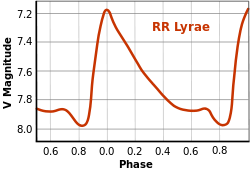RR Lyrae
| Observation data Epoch J2000 Equinox J2000 |
|
|---|---|
| Constellation | Lyra |
| Right ascension | 19h 25m 27.91285s |
| Declination | +42° 47′ 03.6942″ |
| Apparent magnitude (V) | 7.195 (7.06–8.12) |
| Characteristics | |
| Spectral type | A7III - F8III |
| U−B color index | +0.172 |
| B−V color index | +0.181 |
| Variable type | RR Lyr |
| Astrometry | |
| Radial velocity (Rv) | -72.4 km/s |
| Proper motion (μ) |
RA: -109.68 mas/yr Dec.: -195.75 mas/yr |
| Parallax (π) | 3.78 ± 0.19mas |
| Distance | 860 ± 40 ly (260 ± 10 pc) |
| Absolute magnitude (MV) | 0.600 ± 0.126 |
| Details | |
| Mass | 0.65 M☉ |
| Radius | 5.1 to 5.6 R☉ |
| Luminosity | 49 ± 5 L☉ |
| Surface gravity (log g) | 2.4 ± 0.2 cgs |
| Temperature | 6,125 ± 50 K |
| Metallicity [Fe/H] | –1.16 dex |
| Other designations | |
| Database references | |
| SIMBAD | data |
RR Lyrae is a variable star in the Lyra constellation, located near the border with the neighboring constellation of Cygnus. As the brightest star in its class, it became the for the RR Lyrae variable class of stars and it has been extensively studied by astronomers. RR Lyrae variables serve as important standard candles that are used to measure astronomical distances. The period of pulsation of an RR Lyrae variable depends on its mass, luminosity and temperature, while the difference between the measured luminosity and the actual luminosity allows its distance to be determined via the inverse square law. Hence, understanding the period-luminosity relation for a set of local RR Lyrae-type variable stars allows the distance of more distant stars of this type to be determined.
The variable nature of RR Lyrae was discovered by the Scottish astronomer Williamina Fleming at Harvard Observatory in 1901.
The distance of RR Lyrae remained uncertain until 2002 when the Hubble Space Telescope's Fine Guidance Sensor was used to determine the distance of RR Lyrae within a 5% margin of error, yielding a value of 854 light-years (262 parsecs). When combined with measurements from the Hipparcos satellite and other sources, the result is a distance estimate of 860 ly (260 pc).
This type of low-mass star has consumed the hydrogen at its core, evolved away from the main sequence, and passed through the red giant stage. Energy is now being produced by the thermonuclear fusion of helium at its core, and the star has entered an evolutionary stage called the horizontal branch (HB). The effective temperature of an HB star's outer envelope will gradually increase over time. When its resulting stellar classification enters a range known as the instability strip—typically at stellar class A—the outer envelope can begin to pulsate. RR Lyrae shows just such a regular pattern of pulsation, which is causing its apparent magnitude to vary between 7.06–8.12 over a short cycle lasting 0.56686776 days (13 hours, 36 minutes). Each radial pulsation causes the radius of the star to vary between 5.1 and 5.6 times the Sun's radius.
...
Wikipedia

